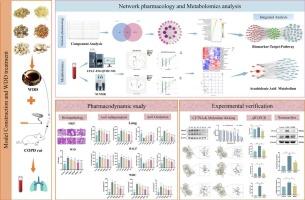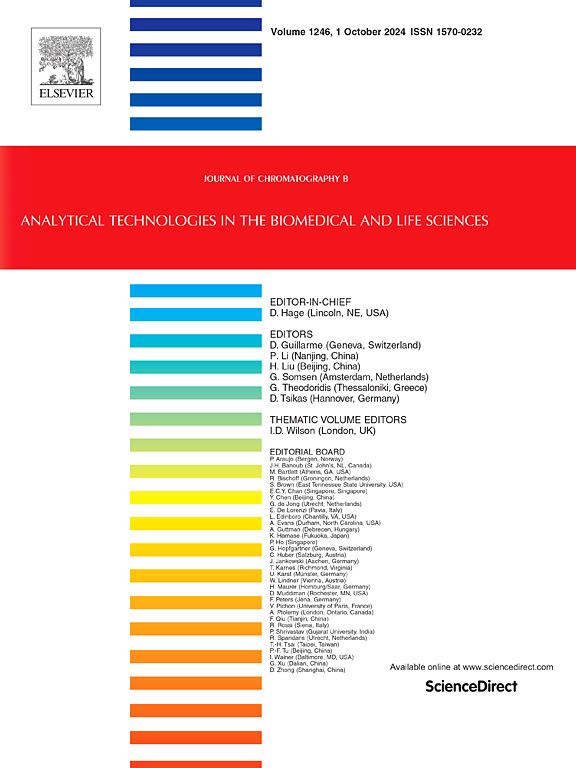综合网络药理学、代谢组学及实验验证,揭示文丹汤治疗慢性阻塞性肺疾病的药理物质及作用机制
IF 2.8
3区 医学
Q2 BIOCHEMICAL RESEARCH METHODS
引用次数: 0
摘要
温胆汤是一种经典的化痰方,已被公认为治疗慢性阻塞性肺疾病(COPD)。然而,WDD在COPD中的治疗成分和机制尚不清楚。因此,我们结合UFLC-ESI-Q/TOF-MS及后续的网络药理学对WDD的成分进行了广泛的分析策略,并通过多技术代谢组学和分子生物学手段进行了适当的生物样品制备,发现PTGS2、花生四烯酸(AA)代谢和PI3K-AKT信号通路等关键因素是抗copd作用的潜在核心因素。随后,基于COPD大鼠模型,观察WDD对肺损伤、炎症和氧化应激的显著衰减作用呈剂量依赖性。代谢组学分析显示,WDD干预可恢复65项COPD生物标志物。综合分析表明AA代谢是主要的代谢途径。从对接拟合和热稳定性等方面,对AA代谢途径中重要靶点PTGS2和PLA2的重要意义以及它们与WDD关键成分柚皮素和黄芩苷的强大结合亲和力进行了表征和验证。值得注意的是,WDD显著逆转了COPD引起的AA代谢途径关键靶点蛋白和mRNA的上调水平。因此,本研究从成分和作用机制等方面揭示了WDD对COPD的疗效,提示了WDD对COPD的有效治疗和临床应用。本文章由计算机程序翻译,如有差异,请以英文原文为准。

Integrated network pharmacology, metabolomics and experimental validation to reveal the pharmacological substances and mechanism of Wendan decoction on chronic obstructive pulmonary disease
Wendan Decoction (WDD), a classic formula for the expectoration of phlegm, has been acknowledged for the management of chronic obstructive pulmonary disease (COPD). Nevertheless, the therapeutic components and mechanism of WDD in COPD remain elusive. Hence, an analytical strategy for extensive investigation of the constituents in WDD combining UFLC-ESI-Q/TOF-MS and subsequent network pharmacology was conducted, and the appropriate preparation of bio-samples was involved with mechanistic bioanalysis including multi-technique metabolomics and molecular biological means, that pivotal factors such as PTGS2, arachidonic acid (AA) metabolism, and PI3K-AKT signaling pathway were recommended as potential central elements for the anti-COPD effects. Subsequently, based on the rat model of COPD, a dose-dependent manner for the significant attenuation effect of WDD on pulmonary injury, inflammation, and oxidative stress was observed. Metabolomics analysis revealed the restoration of 65 COPD biomarkers by WDD intervention. A comprehensive analysis highlighted AA metabolism as the predominant metabolic pathway. The significance of vital targets within the AA metabolism pathway, including PTGS2 and PLA2, and their robust binding affinities with key constituents of WDD such as naringenin and baicalin were characterized and verified from the aspects of docking fitting and thermal stability. Notably, the upregulation levels of protein and mRNA of key targets within the AA metabolism pathway caused by COPD was significantly reversed by WDD. Hence, the efficacy of WDD against COPD was uncovered from the aspects of components and mechanism in this research, implying the effective treatment of COPD and the clinical application of WDD.
求助全文
通过发布文献求助,成功后即可免费获取论文全文。
去求助
来源期刊

Journal of Chromatography B
医学-分析化学
CiteScore
5.60
自引率
3.30%
发文量
306
审稿时长
44 days
期刊介绍:
The Journal of Chromatography B publishes papers on developments in separation science relevant to biology and biomedical research including both fundamental advances and applications. Analytical techniques which may be considered include the various facets of chromatography, electrophoresis and related methods, affinity and immunoaffinity-based methodologies, hyphenated and other multi-dimensional techniques, and microanalytical approaches. The journal also considers articles reporting developments in sample preparation, detection techniques including mass spectrometry, and data handling and analysis.
Developments related to preparative separations for the isolation and purification of components of biological systems may be published, including chromatographic and electrophoretic methods, affinity separations, field flow fractionation and other preparative approaches.
Applications to the analysis of biological systems and samples will be considered when the analytical science contains a significant element of novelty, e.g. a new approach to the separation of a compound, novel combination of analytical techniques, or significantly improved analytical performance.
 求助内容:
求助内容: 应助结果提醒方式:
应助结果提醒方式:


